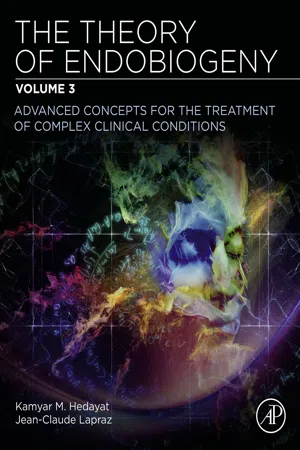
The Theory of Endobiogeny
Volume 3: Advanced Concepts for the Treatment of Complex Clinical Conditions
- 325 pages
- English
- ePUB (mobile friendly)
- Available on iOS & Android
The Theory of Endobiogeny
Volume 3: Advanced Concepts for the Treatment of Complex Clinical Conditions
About this book
Theory of Endobiogeny, Volume 3: Advanced Concepts for Treatment of Complex Clinical Conditions explains complex and multi-factorial disorders and diseases using the theory of endobiogeny. It provides detailed applications of biological modeling, in-depth assessment into common disorders, an endobiogenic analysis, guidance on using biological modeling tools, and suggestions for treatment using standard of care treatments that also take into account diet, lifestyle and medicinal plants. This approach is an evolution in thinking from reductionism to holism, offering advice for symptomatic treatments that can be used in conjunction with a new way of thinking about diseases and disease management.- Covers complex and multi-factorial disorders and diseases using the theory of endobiogeny- Provides detailed applications of biological modeling that can be used within current clinical practice- Extends systems biology from the cell level to the physiology level using pattern recognition
Frequently asked questions
- Essential is ideal for learners and professionals who enjoy exploring a wide range of subjects. Access the Essential Library with 800,000+ trusted titles and best-sellers across business, personal growth, and the humanities. Includes unlimited reading time and Standard Read Aloud voice.
- Complete: Perfect for advanced learners and researchers needing full, unrestricted access. Unlock 1.4M+ books across hundreds of subjects, including academic and specialized titles. The Complete Plan also includes advanced features like Premium Read Aloud and Research Assistant.
Please note we cannot support devices running on iOS 13 and Android 7 or earlier. Learn more about using the app.
Information
Allergic disorders
Abstract
Keywords
Introduction
Table of contents
- Cover image
- Title page
- Table of Contents
- Copyright
- Dedication
- Chapter 1: Allergic disorders
- Chapter 2: Asthma: An integrative physiologic approach
- Chapter 3: A clinical approach to the gonadotropic axis
- Chapter 4: Regulation of the menstrual cycles
- Chapter 5: Menstrual cycle disorders
- Chapter 6: A clinical approach to somatotropic axis
- Chapter 7: Disorders of the prostate: Lower urinary tract obstruction and prostatitis
- Chapter 8: Acne: Disorder of luteal androgen management
- Chapter 9: Motricity of the bowel
- Chapter 10: Disorders of intestinal transit
- Chapter 11: Inflammatory bowel diseases
- Appendix A: Materia Medica
- Index